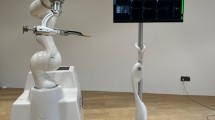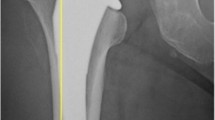Abstract
Background
The benefits of robotic techniques for implanting femoral components during THA are still controversial.
Questions/Purposes
The purpose of this study was to prospectively compare the results and complications of robotic-assisted and hand-rasping stem implantation techniques.
Method
The minimum followup was 5 years (mean, 67 months; range, 60–85 months). One hundred forty-six primary THAs on 130 patients were included in this study. Robot-assisted primary THA was performed on 75 hips and a hand-rasping technique was used on 71 hips.
Results
At 2 and 3 years postoperatively, the Japanese Orthopaedic Association (JOA) clinical score was slightly better in the robotic-assisted group. At 5 years followup, however, the differences were not significant. Postoperative limb lengths of the robotic-milling group had significantly less variance than the hand-rasping group. At 2 years postoperatively, there was significantly more stress shielding of the proximal femur in the hand-rasping group; this difference was more significant 5 years postoperatively.
Conclusions
Substantially more precise implant positioning seems to have led to less variance in limb-length inequality and less stress shielding of the proximal femur 5 years postoperatively.
Level of Evidence
Level II, therapeutic study. See Guidelines for Authors for a complete description of levels of evidence.





Similar content being viewed by others
References
Akhavan S, Goldberg VM. Clinical outcome of a fibermetal taper stem: minimum 5-year followup. Clin Orthop Relat Res. 2007;465:106–111.
Aoki S. BlackBox—data analysis on the WWW. Available at: http://aoki2.si.gunma-u.ac.jp/BlackBox/BlackBox.html. Accessed July 11, 2009.
Bargar WL, Bauer A, Börner M. Primary and revision total hip replacement using the Robodoc system. Clin Orthop Relat Res. 1998;354:82–91.
Brooker AF, Bowerman JW, Robinson RA, Riley LH Jr. Ectopic ossification following total hip replacement: incidence and a method of classification. J Bone Joint Surg Am. 1973;55:1629–1632.
Cohen J. A power primer. Psychol Bull. 1992;112:155–159.
Crowe JF, Mani VJ, Ranawat CS. Total hip replacement in congenital dislocation and dysplasia of the hip. J Bone Joint Surg Am. 1979;61:15–23.
DiGioia AM 3rd, Jaramaz B, Colgan BD. Computer assisted orthopaedic surgery: image guided and robotic assistive technologies. Clin Orthop Relat Res. 1998;354:8–16.
Dorr LD. Optimizing results of total joint arthroplasty. Instr Course Lect. 1985;34:401–404.
Engh CA, Bobyn JD, Glassman AH. Porous-coated hip replacement: the factors governing bone ingrowth, stress shielding, and clinical results. J Bone Joint Surg Br. 1987;69:45–55.
Engh CA, Glassman AH, Suthers KE. The case for porous-coated hip implants: the femoral side. Clin Orthop Relat Res. 1990;261:63–81.
Glas PY, Béjui-Hugues J, Carret JP. [Total hip arthroplasty after treatment of acetabular fracture] [in French]. Rev Chir Orthop Reparatrice Appar Mot. 2005;91:124–131.
Hagio K, Sugano N, Takashina M, Nishii T, Yoshikawa H, Ochi T. Effectiveness of the ROBODOC system in preventing intraoperative pulmonary embolism. Acta Orthop Scand. 2003;74:264–269.
Hananouchi T, Sugano N, Nishii T, Nakamura N, Miki H, Kakimoto A, Yamamura M, Yoshikawa H. Effect of robotic milling on periprosthetic bone remodeling. J Orthop Res. 2007;25:1062–1069.
Harwin SF. Trochanteric heterotopic ossification after total hip arthroplasty performed using a direct lateral approach. J Arthroplasty. 2005;20:467–472.
Honl M, Dierk O, Gauck C, Carrero V, Lampe F, Dries S, Quante M, Schwieger K, Hille E, Morlock MM. Comparison of robotic-assisted and manual implantation of a primary total hip replacement: a prospective study. J Bone Joint Surg Am. 2003;85:1470–1478.
Nakamura T, Mitsuishi K, Kabata T, Sakagoshi D. Fit of VerSys cementless taper stem in total hip arthroplasty. Hip Joint. 2006;32:477–479.
Nishihara S, Sugano N, Nishii T, Miki H, Nakamura N, Yoshikawa H. Comparison between hand rasping and robotic milling for stem implantation in cementless total hip arthroplasty. J Arthroplasty. 2006;21:957–966.
Nishihara S, Sugano N, Nishii T, Tanaka H, Yoshikawa H, Ochi A. Comparison of the fit and fill between the Anatomic Hip femoral component and the VerSys Taper femoral component using virtual implantation on the ORTHODOC workstation. J Orthop Sci. 2003;8:352–360.
Nogler M, Maurer H, Wimmer C, Gegenhuber C, Bach C, Krismer M. Knee pain caused by a fiducial marker in the medial femoral condyle: a clinical and anatomic study of 20 cases. Acta Orthop Scand. 2001;72:477–480.
Paul HA, Bargar WL, Mittlestadt B, Musits B, Taylor RH, Kazanzides P, Zuhars J, Williamson B, Hanson W. Development of a surgical robot for cementless total hip arthroplasty. Clin Orthop Relat Res. 1992;285:57–66.
ROBODOC, a CUREXO Technology Corporation. Available at: http://www.robodoc.com. Accessed July 11, 2009.
Schulz AP, Seide K, Queitsch C, von Haugwitz A, Meiners J, Kienast B, Tarabolsi M, Kammal M, Jürgens C. Results of total hip replacement using the Robodoc surgical assistant system: clinical outcome and evaluation of complications for 97 procedures. Int J Med Robot. 2007;3:301–306.
Shima Y. [Present status of surgical treatment of arthrosis deformans of the hip and summary of therapeutic evaluation] [in Japanese]. Nippon Seikeigeka Gakkai Zasshi. 1971;45:828–831.
Williamson JA, Reckling FWJ. Limb length discrepancy and related problems following total hip joint replacement. Clin Orthop Relat Res. 1978;134:135–138.
Yamauchi Y, Jinno T, Asoh Y, Koga D, Morita S, Muneda D, Shinomiya K. Short-term comparison between ZIMMER VerSys Taper stem and Midcoat stem in bilateral total hip arthroplasty. Hip Joint. 2006;32:469–472.
Author information
Authors and Affiliations
Corresponding author
Additional information
One or more of the authors (NN, NS) have received funding from Imatron Japan Inc.
Each author certifies that his or her institution has approved the human protocol for this investigation, that all investigations were conducted in conformity with ethical principles of research, and that informed consent for participation in the study was obtained.
This work was performed at the Center of Arthroplasty, Kyowakai Hospital and Department of Orthopedic Surgery, Osaka University Medical School, Osaka, Japan.
About this article
Cite this article
Nakamura, N., Sugano, N., Nishii, T. et al. A Comparison between Robotic-assisted and Manual Implantation of Cementless Total Hip Arthroplasty. Clin Orthop Relat Res 468, 1072–1081 (2010). https://doi.org/10.1007/s11999-009-1158-2
Received:
Accepted:
Published:
Issue Date:
DOI: https://doi.org/10.1007/s11999-009-1158-2




